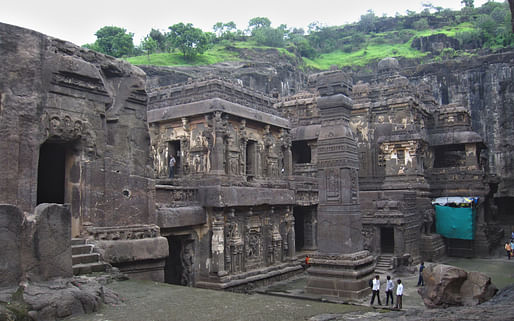
Jul '12 - Jan '13
One may not utter the name Ajanta without mentioning its younger and more illustrious counterpart, Ellora. She may not carry the breathtaking panorama, but her grandeur lies elsewhere. Many of her temples are so grandiose in scale they dwarf all the temples of Ajanta! Her miscellany of temples contains no iteration, and is even at times linked by somewhat clandestine passages, inviting curiosity and exploration.
Her largest and most popularized temple, Kailasanatha, could boastfully embrace 1,000 Ajanta caves within her confines! One hundred years before her ribbon was cut, she was a hill of stone, and slowly, like the draining of a tub, her figure was exposed, smooth and clean from the fresh hand of the mason. She flaunts her parade of elephants, monolithic obelisks, and infinite effigies as though she were atop the acropolis, but her views are barred. At best, 60 ft is the void between her busty effigies and the unadorned bareness of her eternal cage. Her surrounding voids become avenues like the stone valleys of a Florentine street. But in such a vigorous display of labor and an astute example of craftsmanship, she has abandoned all that defines her cave, and joined the aesthetic ranks of an army of thousands.
Ellora's earlier Buddhist caves to the south bear the most familiarity with Ajanta in terms of date and detail, although her lack of litany holds my intrigue. Yes, she is in a well-assorted neighborhood, like Beverly Hills. A sprawling ranch house, eclectic Spanish statehouse, and what's this here, a French Villa! One story, two, alas three! With courtyards, balconies, foyers, and water features, surely the stars of Bollywood dwell here.
The Jain temples more seldomly entertain visitors. From my understanding they lack popularity with the majority of Hindus for cultural reasons unbeknownst to me. This, with her remote post, renders her crowd-less. Three of the four temples lie in adjacency, and the fourth some distance yonder. From their precarious reputation one might expect rubble, but I was delighted to discover the most intricate, ornately carved caverns thus far. Each was multistoried and with granite arms wrapped around their courtyards. The courtyard of cave 31 was unfinished, and therefore quite multitudinous with her datum. A recent surge in rainfall bequests a sculpture of a floor, thus concealing and unveiling herself in accordance with Mother Nature's notorious downpours. It provokes adventures to a courageous feat- a ready and spirited hop, skip and jump.
And if one must query upon the source of my penchant for cave temples, I shall need to site no more than Dhumar Lena, aka cave 29. Mind you, my tastes are not gauged by the ornate and intricate, but rather by the quality of space, light, materiality, form, massing, void, datum, figure ground, hierarchy, and process (If you wish to judge a building so, look no further than the history books, and Kailasanatha).
She occupies a corner lot, her western front a spacious and flat plateau and her southern, the sheerest of cliffs 200 ft into the basin below. Her westwardly entrance is wide and stanchion all but two columns, her girder the mountain. Her facade is paramount and laden, and she lies ajar from both the north and south. Not by horizontal voids as one may conjecture, but rather by the clean shear and doff of two vertical shafts. No other temple of these illustrious Ajanta and Ellora caves may swagger to such a feat as to expose ones insides through more than a single façade. Dhumar Lena is opened thrice. Once to the plateau, once through 100ft of rock to the sky, and once only feet from the cliff's edge, forming a gagged stone sculpture along her contour. Stairs pierce the mountain to the cliff's edge where a walkway of minimal width guides one under a magnificent waterfall. The north courtyard, the yield of such an inmost void, contains a rectangular aperture 2ft wide by 13ft tall. It is the entrance to the exit; a narrow valley carved through the mountain bringing runoff and explorers, alike, henceforth to the assurance of the western plateau.
This is the last I will see of these wondrous cave temples, for tomorrow I venture north into Gujarat and Rajasthan, home of another subterranean temple typology- the step well. I shall nevertheless keep these caves close at mind, and one should not find astonishment upon any resemblance my future work holds to these enkindling structures.
 Kailasanatha from her lofty parapet
Kailasanatha from her lofty parapet
 Kailasanatha's main hall
Kailasanatha's main hall
 Kailasanatha's colonnade and colossal overhang
Kailasanatha's colonnade and colossal overhang
 The Jain temple number 31s unfinished courtyard
The Jain temple number 31s unfinished courtyard
 The prodigious western entrance of Dhumar Lena
The prodigious western entrance of Dhumar Lena
 A view across the gorge from Dhumar Lena
A view across the gorge from Dhumar Lena
 Dhumar Lena cross section
Dhumar Lena cross section
An Indo Inquisition is a thirteen-week train expedition across India. The journey will document the influences of international modernism and British occupation, as well as compare the effects of wealth accumulation, culture, religion, and poverty with economic growth and their effect on the built environment.
No Comments
Block this user
Are you sure you want to block this user and hide all related comments throughout the site?
Archinect
This is your first comment on Archinect. Your comment will be visible once approved.